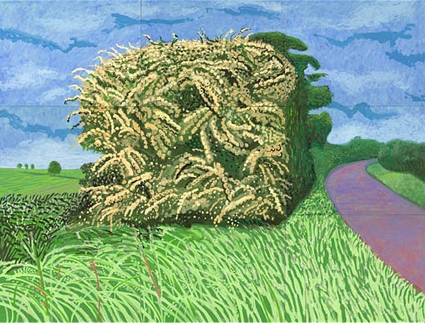David Hockney: A Bigger Picture, at the Royal Academy.
Who on earth is David Hockney? His blockbusting new show at the Royal Academy leaves the question open. One thing is for sure: who he is not, nowadays. He is no longer the owlishly bespectacled, Pop-inclined, ironic young man he was back in the Sixties and Seventies: the painter of graffiti-esque protestations of a love that still, back then, dared not speak its name; the emigre to sun-kissed Los Angeles; the celebrant of swimming pools and lithe male bodies, creator of A Bigger Splash. No, he is none of those. The Hockney of now is a man come home, back to his native North Yorkshire, back to Bridlington, to paint "A Bigger Picture", as the title of the current exhibition would have it.
Most of the 150 works in the show were painted during the last eight years. Nearly all are landscapes. They are mainly strident and often panoramic, painted in an almost gratingly joyous palette of zinging yellow, sappy green, fluorescent purple, screaming pink and candied orange. Yet despite the willed consistency of tone and the relentless focus on a single place, these paintings suggest that Hockney’s identity remains as curiously fractured as the Polaroid collages with which, three decades ago, he announced his turn towards landscape as a theme.
A number of those collages have been included in "A Bigger Picture" as part of the back-story to the new work. Pearblossom Highway, 11-18 April 1986 is a juddering, stuttering, mildly disorientating view of a stretch of sun-baked California as seen from Highway 138, formed from hundreds of interlocking Polaroid photographs. It is a reminder of Hockney’s longstanding preoccupation with the truancies of vision, the ever-mobile nature of the human eye. It is also a homage of sorts: Cubism revisited...


